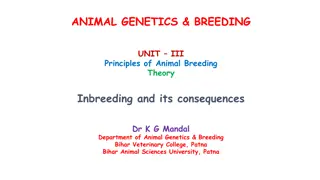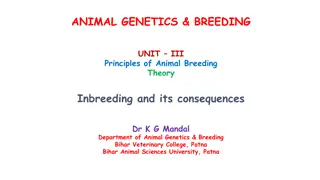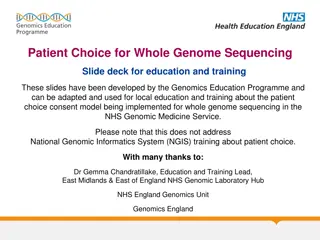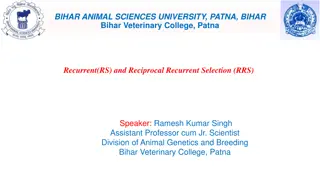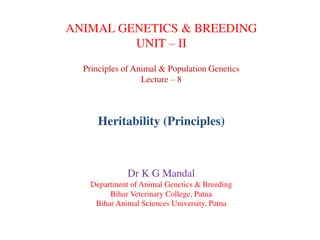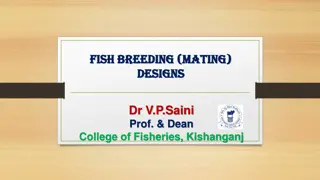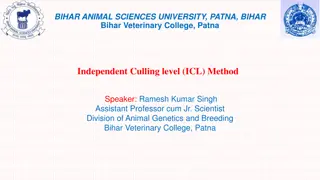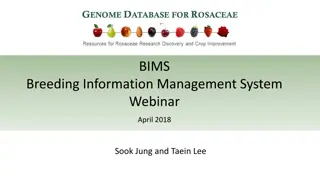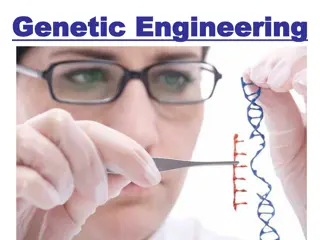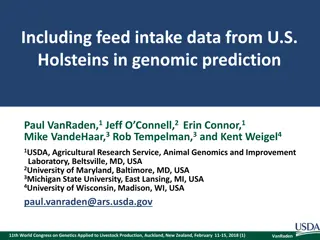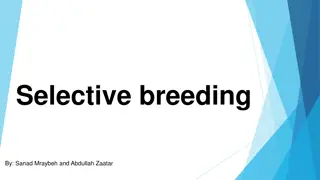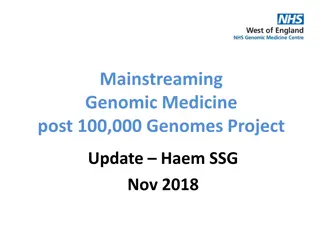Genomic Recursions in Genomic BLUP for Animal Breeding
Explore the application of genomic recursions in single-step genomic best linear unbiased predictor (BLUP) for genetic evaluations in animal breeding. Understand the significance of using genomic data to improve genetic selection, increase accuracy, shorten generation intervals, and enhance genetic gain. Discover the evolution of animal breeding methods over decades and the impact on dairy cattle and broiler chicken production. Uncover traditional genetic evaluation methods and the incorporation of pedigree information for predicting breeding values effectively.
Download Presentation

Please find below an Image/Link to download the presentation.
The content on the website is provided AS IS for your information and personal use only. It may not be sold, licensed, or shared on other websites without obtaining consent from the author. Download presentation by click this link. If you encounter any issues during the download, it is possible that the publisher has removed the file from their server.
E N D
Presentation Transcript
Use of genomic recursions in single- step genomic best linear unbiased predictor (BLUP) with a large number of genotypes Dr. Breno Fragomeni Assistant Professor Animal Science - UConn
Selection Intensity Genetic Standard Deviation Why genomic prediction? Genetic gain per year Higher accuracy Shorter generation interval Higher genetic gain Accuracy Generation Interval
What is animal breeding? What is animal breeding? Mating superior animals to harvest superior progeny 1950 s X 2000 s Broiler Chicken Phenotype=Genetics + Environment > 50% of improvements are due to Genetics Picture: Courtesy of Dr. Nick Dale, Poultry Science, UGA
Dairy cattle 1940 X 2010 Dairy cattle 1940 X 2010 Production Increased from <5,000 to >21,000 pounds of milk per cow in lifetime U.S. Holstein Trend Phenotype Genetic Environment 18000 12000 Milk (lb.) Greatly improved efficiency per unit of milk: 23% of feed intake 35% of water intake 37% carbon footprint 6000 0 1957 1964 1971 1978 1985 1992 1999 2006 Years Adapted from http://aipl.arsusda.gov/eval/summary/trend.cfm
Evaluation Methods Phenotype based Mixed models (genetic) Phenotype BLUP Least Squares Genomics
Traditional Genetic evaluation Traditional Genetic evaluation Aims to identify superior animals with high accuracy Pedigree Phenotype Model Progeny Testing High accuracy Slow Estimated Breeding Value(EBV)
Traditional genetic evaluations Pedigree is accounted for through an average relationship matrix (A) Expected relationships Example: full siblings with no records will always have the same EBV We need the inverse! Henderson rules for inversion (1976)
Genomic Information Genomic Information Available for several animals in different species. Single nucleotide polymorphisms SNPs 50k markers per chip ~ $50
Genomic information and selection Genomic information and selection Inclusion of DNA marker information in the analysis Genomics Pedigree Phenotype Higher accuracy for young animals No more wait for evaluations Model Genomic Breeding Value
Genomic Relationship matrix Genomic Relationship matrix - - dense dense Realized relationship matrix (G) Actual relationships Sire Dam Son Son Proportion of markers in common among animals Dense matrix High computing cost Explicit inversion Soft limitation ~100k Genotypes Several Studies no solution - SO FAR!
Genomic evaluation with a large number of Genomic evaluation with a large number of animals animals US Holsteins - 2017 1,600,000 Number of genotyped animals 1,400,000 Females Males 1,200,000 1,000,000 800,000 600,000 400,000 200,000 0 901 906 910 1002 1005 1007 1009 1011 1101 1103 1105 1107 1109 1111 1201 1203 1205 1207 1209 1211 1301 1303 1305 1307 1309 1311 1401 1403 1405 1407 1409 1411 1501 1503 1505 1507 1509 1511 1601 1603 1605 1607 1609 1611 1701 1703 1705
Single-Step GBLUP H matrix: A relationship matrix that includes genotyped and ungenotyped animals Very simple inverse Genomic evaluation including pedigree, phenotypes and genotypes Genomic estimated breeding value in a single-step Simple modification in existing software Suitable for the same models used in traditional evaluations H 16
ssGBLUP Challenges Dense block in ? ? ? ? 1= ? 1+ ? ? ? ??? Challenge 1: Storage Dense = all elements to be stored. 74.5 GB for ? = 100K; 7.4 TB for ? = 1 million (with full storage) Challenge 2: Computation time Inversion cost ?(?3) Impossible for huge matrix even with recent computers
Genomic recursions for G Genomic recursions for G- -1 1 Animals may contribute or not to predictions Hereby termed proven and young animals From pedigree: ?????? =????+??? + ????????? ???????? 2 In Genomics: ?????? = ??? ??????? + ????????? ???????? Algorithm for proven and young (APY) ?????? = ?????? ??? ????? ??????? + ????????? ???????? Recursions: ?????? = ?????? ??????? + ????????? ???????? Population can be partitioned in two classes Young animals contribution to prediction can be neglected
Recursions in A and G Pedigree relationships + u u s di = + i u 1 1 = A I P M I P ( )' ( ) i i 2 Genomic relationships i-1 ui= pijuj+ ei 1 1 = G I P M I P ( )' ( ) i=1 Genomic relationships contributions only from proven animals = 0 in GBLUP ??= ?????+ ?????+?? ?="?????" ?="??????" p=proven y=young 10/1/2024
Recursions in A and G Pedigree relationships + u u s di = + i u 1 1 = A I P M I P ( )' ( ) i i 2 Genomic relationships i-1 ui= pijuj+ ei 1 1 = G I P M I P ( )' ( ) i=1 Genomic relationships contributions only from proven animals -1 pp 0 -P ' I G 0 0 y -1 -1 = + G = + M -P I ' u p u y i ij j i = " " j proven p=proven y=young 10/1/2024
Inverse of genomic relationship matrix Inverse of genomic relationship matrix Regular G Inverse Ignore inverse term among young animals Sparse G matrix No software limitation Inversion only for small partition of relationship matrix 2 less storage 3 less computations APY G Inverse
Simulation Study 1.1 Million simulated animals, following dairy cattle population structure 45k markers available for genotypes animals 25,000 genotyped animals 7,200 genotyped sires with progeny 12,800 genotyped young bulls without progeny 5,000 genotyped cows with records APY Algorithm Scenario 1: 7,200 sires treated as proven 12,800 young bulls treated as young Scenario 2: 7,200 sires treated as proven 12,800 young bulls treated as proven 5,000 cows treated as young
Results Scenario 01 Method # Iterations ssGBLUP 226( 7) APY 206( 5) 23
Results - Scenario 02 Method # Iterations ssGBLUP 231( 7) APY 209( 6) 24
Real Data US Holstein final score (h2=0.31) 10.1M animals in pedigree file 11.4M records from ~7M cows 100k genotyped animals 23k sires 16k high accuracy bulls 27k dams 50k young 25
Real Data ssGBLUP with regular G inverse ssGBLUP with APY G inverse Treated as proven Sires Dams Sires + Dams High Accuracy sires Random animals 2k, 5k, 10k, 15k, 20k 4 samples each Correlation between regular and apy GEBV for the 50k young animals 26
Correlations Definition of subset All Rounds to convergence 567 Animals in subset Correlation 100k 1 Sires 23k 0.99 432 Sires+cows 50k 0.99 428 Cows 27k 0.99 797 Sires > 5 progeny 16k 0.99 415 27
Correlations Random animals in recursions Number of Animals 0.99(0.0005)0.99(0.001) 0.99(0) 0.97(0.0005) CORRELATION(SD) 0.94(0.0005) 2k 5k 10k 15k 20k 29
Implications Academic Industry New understanding of genomic dimensionality New area of research Interest from groups all over the world Limitation is over: genomic selection for millions of animals Companies and breed associations are adopting the method




